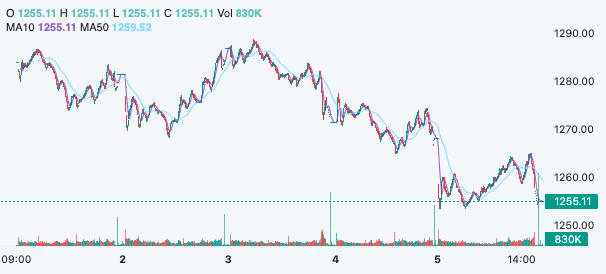The Vietnamese stock market experienced its sharpest weekly decline since the beginning of the year due to profit-taking pressure from investors. The market had a relatively positive start with a slight increase on April 2, however, increased selling pressure caused the VN-Index to continuously decline in the remaining 4 sessions of the week.
After strong fluctuations, at the end of the week, VN-Index decreased by 28.98 points, equivalent to 2.26% compared to the previous week to 1,255.11 points. HNX decreased by 1.9% to 239.68 points.
The real estate sector was a rare bright spot in the market last week, notably DIG increased by 0.3% and NVL increased by 6.1%. The banking and securities sectors had the least positive performance and made strong adjustments.
Net selling pressure from foreign investors continues to be a negative factor affecting the market. Last week, foreign investors net sold 15,681 billion VND, this is the 7th consecutive week of net selling.
In addition, the USD/VND exchange rate surpassed its historical peak and headed towards the 25,000 mark despite the State Bank's net withdrawal efforts through the OMO channel, which also made investor sentiment negative.

VN-Index performance last week (Source: FireAnt).
Regarding developments in the coming trading week, Mr. Dinh Quang Hinh - Head of Macroeconomics and Market Strategy Department, Analysis Department of VNDIRECT Securities Company said that the VN-Index is currently in a short-term downward inertia and may adjust to the support zone of 1,230 points (+/-10 points).
However, investors should not rush to buy the bottom in the context of the exchange rate heat showing no signs of cooling down and the market volatility is at a high level. Investors need to patiently observe the market's demand in the support zone around 1,230 points as well as wait for the market to establish a short-term balance before making a new disbursement decision.
On the contrary, for investors with high leverage ratios, it is necessary to adhere to discipline and watch for recovery periods to reduce leverage ratios to control portfolio risks.
Meanwhile, Mr. Bui Van Huy - Director of DSC Securities Branch commented that the factors supporting the market in the medium and long term have not been violated, but the market needs to find a balance with new developments in the domestic and international context.
In the world, major stock markets show signs of weakness in the short term, risky assets such as cryptocurrencies also adjust strongly. Meanwhile, US government bond yields continue to rise and the commodity market continues to heat up, causing expectations for the Fed's interest rate cut to decrease significantly. The recent return of geopolitical risks has pushed the commodity market to increase sharply, this is an unknown that needs to be observed.
Domestically, it is the management agency's balance of trade-offs between monetary policy factors, economic growth, and domestic capital flow strength on one side and exchange rate factors and foreign capital flow on the other.
Experts from DSC said that the market has experienced a long increase and if the market needs a few weeks or longer to find a new equilibrium point, it is also normal for it to accumulate again.
However, to confirm the trend, the pillars of the bull market need to be carefully evaluated. For a market that is as fragmented as in the past and is affected by many large stocks with not too much liquidity, the score is not too important, the important thing is that the market needs to find a new equilibrium and the macro factors need to be balanced soon.
The nearest support of the market is around 1,240 points, strong support is around 1,200 points. Meanwhile, the strong resistance zone is the 1,280-1,300 point zone .
Source






![[Photo] Hanoi morning of October 1: Prolonged flooding, people wade to work](https://vphoto.vietnam.vn/thumb/1200x675/vietnam/resource/IMAGE/2025/10/1/189be28938e3493fa26b2938efa2059e)






























![[Photo] Panorama of the cable-stayed bridge, the final bottleneck of the Ben Luc-Long Thanh expressway](https://vphoto.vietnam.vn/thumb/1200x675/vietnam/resource/IMAGE/2025/9/30/391fdf21025541d6b2f092e49a17243f)
![[Photo] The 1st Congress of Phu Tho Provincial Party Committee, term 2025-2030](https://vphoto.vietnam.vn/thumb/1200x675/vietnam/resource/IMAGE/2025/9/30/1507da06216649bba8a1ce6251816820)
![[Photo] President Luong Cuong receives President of the Cuban National Assembly Esteban Lazo Hernandez](https://vphoto.vietnam.vn/thumb/1200x675/vietnam/resource/IMAGE/2025/9/30/4d38932911c24f6ea1936252bd5427fa)
































































Comment (0)